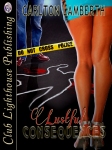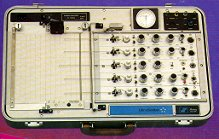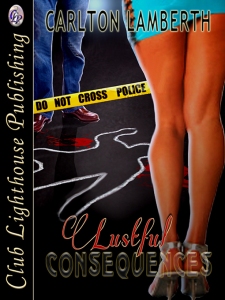“Eliminate all other factors, and the one which remains must be the truth.” ~ Sherlock Holmes “The Sign of the Four”
Not a bad idea, Mr. Holmes!
If you missed part I, you can find it here. We’re joined by Carl Lamberth, a retired homicide detective, who’s been discussing his most interesting “on call” case.

![TheDevil'sSin [514130]](https://crimewriterblog.wordpress.com/wp-content/uploads/2015/08/thedevilssin-514130.jpg?w=113&h=150)
In all my years of police investigation I’ve investigated cases of all stages of solvability. Some cases were like dominoes…each piece neatly falling into place one after the other; some were like a giant jigsaw puzzle…all the pieces were there, but the difficulty lay in finding which pieces which fit together. After two months of searching for all the pieces to this case, I was beginning to believe all the pieces were not on the table and the puzzle would never be finished.
This murder created wide public attention. Both print and TV news media continuously asked for updates on the case. I was pulled off my other investigations and told to focus solely on this case. I was even pulled off the “on-call” schedule.
I worked hand in hand, day in/day out, with a state SBI agent. A typical day for us began around 7:30 – 8:00 AM and would end anywhere between 9:00 – 11:00 PM. We became a good team, good working partners.
As the reward to solve this cases reached $7,000 (a lot of money for the mid 1980’s), phone tips quadrupled in number. We followed up on every one of the tips. A lot of time and effort went into examining these follow-ups. And every follow-up required a typed report for the case file. My case file was growing thicker every day. This was back in the day before desk top or laptop computers. We used an instrument most likely foreign to the techie generations of today – it was called an IBM Selectric typewriter!
Unfortunately, all tips would lead nowhere. It became very frustrating to go to work. My chief would routinely call me into his office wanting updates, and I had l little in updates to offer. I even began to feel like he was starting to doubt my investigative abilities.
Two months or so into this investigation, I was headed into work when I was summoned over the radio to respond to a homicide crime scene in the same general neighborhood where the murder I was investigating occurred. Arriving, I met with the “on-call” investigator, who had responded to the scene.
He told me, “We’ve got another one.”
An elderly female was found stabbed to death in her home by family members. The similarities in the two cases seemed obvious:
- Both victims were elderly females who lived alone (in my case the victim’s son technically lived at home but he was never there, his drug problems kept him elsewhere).
- Both victims were stabbed to death.
- Both victim’s homes were ransacked, robbery appearing to be at least part of the motive.
- The two victims lived in the same neighborhood within a 3 block area of each other.
As you can imagine, the news of this second homicide sent shockwaves through the community and city. A suspected serial murderer appeared to be on the loose, preying upon unsuspecting elderly women.
To say “the shit hit the fan” is an understatement.
As I stared at the victim and the crime scene, a cold chill shimmied down my back. Had my lack of investigative skills caused this poor woman to meet an untimely death? Now, I was even more frustrated, to the point of being downright angry.
Upon closer observation, I couldn’t help but note obvious differences between the two cases. Unlike the first victim, this lady was far from wealthy. Also unlike the first incident, forced entry had been made into this victim’s residence. And finally, unlike the first victim, this lady, although murdered, did not receive the amount of violence present in the first case. These differences were noted, but the similarities were too obvious to ignore…at least for now.

Similar to the knife.
The autopsy would reveal this woman died from three stab wounds to the neck and upper chest. The aorta artery was severed by one of the stab wounds–the fatal wound. The knife used was 3 to 4 inches in length at best and maybe ½ inches or so in width. A good size pocket knife, or maybe a steak knife.
Just like the first case, the murder weapon was not present at the crime scene. Unlike on TV crime shows or Hollywood movies where we see knives sticking out of their victims, I can only recall one time where I responded to a stabbing to find the murder weapon was left in the victim’s body. In that case, it was a large pair of scissors buried up to the handle into the victim’s chest. Even so, this victim’s throat was also cut from ear to ear and the suspect fled with the knife.
It’s also been my experience to be fairly rare to actually recover the knife used in a stabbing death. Suspects usually carry away their bladed weapons and discard them, never to be found again.
Crime scene analysis revealed little information of evidentiary value on this case. But unlike the first homicide, a promising suspect was established early on. Stolen property taken the night of the murder was recovered. Witness interviews led to a person of interest. A short time later, he would be confirmed as our suspect, someone we in the police community knew well due to his local criminal activity.
Although not officially assigned to this second homicide, I worked with two investigators from our department who were assigned this case. Probable cause was soon established and warrants were obtained for this subject, charging him with murder. There was only one problem. Our suspect had fled the state, headed up north to the New Jersey area where he had family. New Jersey authorities were notified and luckily, within a few weeks he was located and arrested. He was extradited back to North Carolina to stand trial.
As for my case, the hope was to somehow link this suspect to my murder case. Unfortunately though, no physical evidence connected him. And there were those damn differences that kept going through my and my partner’s minds.
Did we have a serial murderer in the making, or were these two crimes a terrible coincidence?
Back in North Carolina, our suspect from the second homicide “lawyered up” right away. If he was the suspect, I’d have to solve my case without an interview and/or confession.
Several more months passed without any positive results. My SBI agent partner and I “pounded the sidewalk” in search of any way to connect the jailed suspect to our investigation.
My case was getting “colder” by the day; I prayed for a break of some kind.
At the time, the North Carolina State Bureau of Investigation had a unit called the Murder Un-Solve Team or M.U.S.T. Unit. This unit was made up of four top-notch SBI agents with numerous years of experience and expertise in homicide investigations. This unit was assigned to look into my murder case and assist in solving the crime.
I had mixed emotions about these guys coming in and scrutinizing everything we had done. But, if a few more pairs of eyes and minds could help solve the case, it would be worth it. As it turned out, these agents were great to work with. After a week we were all on the same page with a common goal and mission.
However, after about a month they were about as frustrated as we were. They agreed the suspect in the second murder probably was not the attacker of my victim, based on my observations (stated above). The MUST unit’s policy was to review a homicide case for overlooked or mishandled clues, wrong deduced assumptions, or any other misguided conclusions. If none were found, and if their services were not beneficial, they moved on to another case.
So, they moved on.
Though relieved to hear our case was spot-on as far as our investigation, we still had no suspect. I was pulled off special assignment and given a full case load again. My partner returned to the SBI and worked other investigations. However, whenever something would arise concerning the murder case, we’d drop everything and check it out.
One day in November, 1986, I received a phone call from the SBI agent. “Do you want to take a trip to the mountains?” he asked.
The city I worked for is in the foothills of the western North Carolina Mountains, maybe an hour’s drive to the Blue Ridge Mountains of the Appalachian Mountain range. Now, I love the mountains and am always looking for a reason to head up to “Heaven’s steps,” but I was confused as to why he’d asked me this.
Apparently, his supervisor received a phone call from the warden of the state prison in that area. An inmate claimed to have valuable knowledge which would solve our case. Needless to say, we piled in the car that day and headed up the mountain.
We first met with the prison warden, who told us an inmate in his unit was incarcerated on two breaking and entering charges and awaiting trial on a third, as well as a forgery charge in our county. He’d contacted the warden, advising he had information on a murder—our murder!
First, we interviewed the inmate’s cellmate to see what, if anything, he’d told him. He said the inmate told him he knew who killed the elderly woman found on Easter Sunday. He said this inmate claimed he knew who committed the murder and was willing to testify if his new charges were dropped and he received the $7000. reward.
Next, we interviewed the inmate, who claimed before he was sent to prison, an acquaintance confided that he murdered the woman on Easter weekend. He said his friend thought the house was empty when he entered to burglarize the residence. He said his friend killed the woman after she awoke to find him in the house and confronted him.
This inmate offered a lot of details about the murder. One thing the police try not to do is divulge too much detail to the media in press releases concerning high profile cases. So, it was interesting that he had so many details.
We took the inmate’s statement and left, advising him we would be back in touch soon. On our trip down the mountain, my partner and I discussed our latest lead. Our conclusion was, this inmate knew too much about the crime. He seemed to offer more and more details—accurate details–especially when pressed after we displayed doubts. By the time we reached the bottom of the mountain, we were convinced this inmate was most likely present at the crime scene that night and may even have direct involvement in the murder.
We decided not to divulge our suspicions. A few days later, we traveled back up the mountain for a second interview. We told him we believed him, but needed to confirm his story. We asked if he’d take a polygraph. He agreed.
The following week we obtained a writ to have the inmate transferred from the state prison to our county jail. On the day of the polygraph test, my partner and I waited in anticipation in a separate room. After about an hour and a half, the SBI polygraph examiner walked into our room.
The inmate failed the test. Deception present in his answers to the following relevant questions:
- Were you present during the murder of this woman?
- Did you participate in the murder of this woman?
- Did you kill this woman?
How did this case turn out? Tune in for the exciting conclusion.

Connect with Carl on Twitter @CarltonLamberth
BUY LINKS:
http://www.barnesandnoble.com/w/the-devils-sin-carlton-lamberth/1122413864?ean=2940150998582
http://clublighthousepublishing.com/productpage.asp?bNumb=370
http://clublighthousepublishing.com/productpage.asp?bNumb=390
http://www.amazon.com/Carlton-Lamberth/e/B00NP0M6T0/ref=sr_tc_2_0?qid=1439351560&sr=1-2-ent
If you enjoyed this post please share on your favorite site. It's only a click or two, and it would be greatly appreciated.





![TheDevil'sSin [514130]](https://crimewriterblog.wordpress.com/wp-content/uploads/2015/08/thedevilssin-514130.jpg?w=113&h=150)



![TheDevil'sSin [514130]](https://crimewriterblog.wordpress.com/wp-content/uploads/2015/08/thedevilssin-514130.jpg?w=225&h=300)





